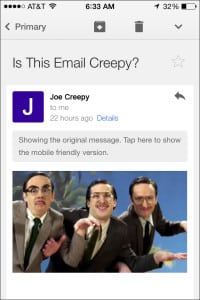 One of my favorite brands has been coming on a bit too strong, and it’s starting to creep me out.
One of my favorite brands has been coming on a bit too strong, and it’s starting to creep me out.
I recently made a few home improvements and have spent more time at the big-box home improvement stores than usual. Even if your most complex home repair is hanging a picture on the wall, you know that you rarely buy everything you need in one visit.
Although I can use multiple tools to try to get the job done, such as browse the store’s site ahead of time, build a shopping list with a wish list or shopping cart, and use in-store pick-up to avoid the hassle of tirelessly searching their shelves, I typically need another trip to finish the task.
From the marketer’s perspective, this increase in brand interaction means that I have gone from an active, non-buying subscriber to a very active shopper and repeat purchaser.
Naturally, this jolt of activity will result in more triggered emails. In fact, I encourage retailers to set up automated emails that are triggered throughout the purchase path and a post-purchase email series to extend engagement after an order has been submitted. These messages are meant to foster long-term engagement and boost sales.
However, there can, be too much of a good thing. If you’re not careful, this is where you can begin to creep out your customers.
On my list of recommended triggered messages, this home improvement retailer checked many of the boxes. The problem isn’t the quality of their automated messages, but the frequency in which they are triggered.
Here are the emails I received in less than 10 days:
- Product Page Abandonment Reminder
- Shopping Cart Reminder
- Product Review Request
- In-Store Purchase “Thank You” Email
- Online Purchase “Thank You” Email
- In-Store Pick-Up Confirmation
- Regular Promotional Emails
All of the emails were nicely designed, had attention-grabbing subject lines and seemed to be well thought out – definitely a notch above what I see from many retailers. However, my inbox was quickly inundated as they triggered multiple emails with each related action. For example, if I browsed a few products, I triggered a product page abandonment email each time. If I added a few potential purchases to my cart, I received a cart reminder email each time. Order confirmations and post-purchase emails were overlapping with marketing messages and abandonment reminders.
This cacophony of emails quickly became annoying and very overwhelming. I started to feel like the brand was trying way too hard to get my attention (and my dollars)! Basically, they were starting to creep me out and I couldn’t find a way to make it stop.
The good news is that you can easily beat the creep factor by prioritizing your automated messages and setting limits on how frequently they are sent. Here are some quick tips on how you can adjust automated messages to be less overwhelming but still effective.
Prioritize Automated Messages
Transactional messages, such as order and shipping confirmations, should take top priority over automated marketing messages. While triggers for product page and cart abandonment can be serious moneymakers, you should analyze your cart reminder performance data to see if recent purchasers are responding to these emails or simply ignoring them. It may be beneficial to suppress these messages for a brief period of time after an order has been made. Remember, recent purchasers may also be receiving your regular promotional emails or a message from a welcome series if they recently opted in.
Limit Repeat Triggers
Many marketers focus on optimizing the content of automated messages and testing the timing of the trigger, but don’t factor in how many times a shopper could qualify to receive the email. Do shoppers really need a product page abandonment reminder every time they visit a product page but fail to complete an order? Set limits so shoppers will not be bombarded with all of your “friendly reminders.” Be sure to test your sending frequency for these messages. Try limiting reminders to one per week or consolidate a week’s worth of browsed items into one email. Additionally, many retailers include a discount in triggered messages, which can quickly train shoppers to abandon their carts and wait for the special offer. Adjust cart reminders so that incentives are only included every # time a shopper abandons or a maximum number of times in a 90-day period. Any additional abandonment events can trigger a customer service-themed message without the incentive.
Don’t Forget about Promotional Emails
As you review the timing and frequency of your triggered messages, don’t forget that your promotional email sends can overlap with your automated emails. Many consumers can distinguish between an automated message and emails such as your weekend sale promotion; however, having several of these hit the inbox in a short period of time could overwhelm and frustrate your shoppers. Identify periods of peak traffic, such as the holidays, when email frequency increases can easily bombard your shopper’s inbox. Also, consider staggering the sending of these messages so the inbox takes less of a hit during a specific time of day.
We all want to keep our customers informed about our latest promotions while providing a relevant and engaging experience. Automated messages can be utilized to target messages that help keep the customer shopping and engaged, but they must be used responsibly. As you add new automated emails to your marketing arsenal, be sure to maintain a balanced dialogue with your customers and don’t come on too strong. It can be creepy.
Jim Davidson is head of research at Bronto Software.
